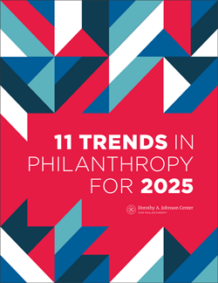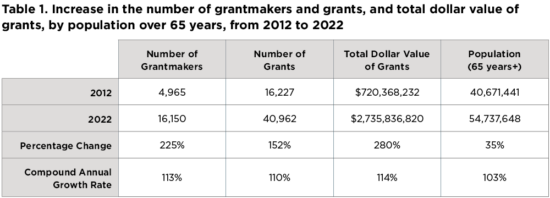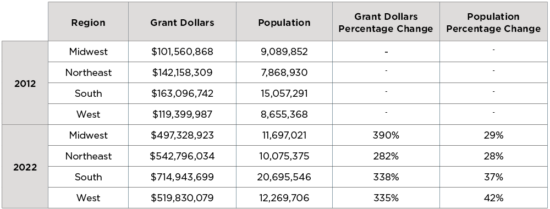America’s Population is Rapidly Aging. Can Philanthropy Keep Up?


 This article was first published in our 11 Trends in Philanthropy for 2025 report. Explore the full report here.
This article was first published in our 11 Trends in Philanthropy for 2025 report. Explore the full report here.
Want the latest trends, research, and more delivered right to your inbox? Subscribe to the Johnson Center email newsletter.
Americans today are living longer and having fewer babies, shifting the median age from 30 years old in 1980 to 38.9 years old in 2022 — the oldest it has ever been (Population Reference Bureau, 2024). Across the country, the number of adults ages 65 and older is projected to increase from 17% to 23% of the total population within the next three decades. What’s more, a major turning point is coming: by 2034, the number of adults 65 and older (77 million) is projected to surpass the number of children under 18 (76.5 million) for the first time in U.S. history (U.S. Census Bureau, 2018).
Danielle Arigoni, former director of AARP Livable Communities, presciently urged that the dominant paradigm for community development must shift to embrace this simple reality: we are all aging (2018).
In 2017, Giving USA estimated that only 6% of nonprofits focused on providing services to older adults. While that number seems small, another number provides a different picture from the last decade: Johnson Center analysis of Foundation Center data (2024) indicates that the number of grantmakers funding nonprofits supporting older adults increased by 225% from 2012 to 2022. (See Table 1.) More funders and more resources are entering the space, but it remains to be seen whether philanthropy will (or should) be able to meet the growing need.

Source: Johnson Center (2024) analysis of Foundation Center data and U.S. Census Bureau American Community Survey 5-year estimates, Table S0103. https://data.census.gov/
While a review of summary grantmaking data shows a massive increase in funding for projects related to an aging population (280%) over the last decade, it is uncertain whether this level of spending aligns with growing levels of need, or the role of nonprofits and philanthropic funding to meet community needs. Furthermore, older-adult issues connect across sectors, making it challenging to determine the extent of grantmaking that supports them relative to various causes and community needs. This analysis uses grantmaking data designated as “Senior” by the Foundation Center.
Growth of the older adult population and its implications for how we fund services has been forecasted for years (National Research Council, 1996; Lim Rogers et al., 2000; Wallace, 2015). However, notable movement is taking place that will push the philanthropic field into action:
The Older Americans Act (OAA) – One of the country’s foremost pieces of legislation for aging services turns 60 this year. Grantmakers in Aging called its reauthorization “a historic opportunity” to integrate lessons learned from the pandemic into support for older adults and to commit funding levels to match the needs of communities (2024a, para. 1).
A paradigm shift in caregiving is evident – Paris (2022) asserted that the sector is increasingly interested in funding aging issues since the COVID-19 outbreak, especially given its intersections with caregiving. In 2021, the Ford Foundation published “The Price We Pay: Why We Need to Redefine Care in America” (Gupta) while the following year, the Administration for Community Living (the main implementing body of OAA programs) launched the first National Strategy to Support Family Caregivers, with strong backing from philanthropy (Paris, 2023).
Volunteer Base Changes
Volunteering and civic engagement have long been shown to provide benefits to older adults with their contributions worth billions per year to our country (Population Reference Bureau, 2011; White House Conference on Aging, 2015). Moreover, Ladner (2023) lauded the volunteer contributions of older adults, finding that from 2002 to 2021, their share of total volunteer hours grew much more than their proportion of the overall population. However, in contrast, recent data indicates a decline in older adult volunteering that has been largely attributed to the pandemic: volunteer rates for baby boomers (ages 58–76) and seniors (ages 77+) fell from 24% pre-pandemic to 17% in 2023 (Collins, 2023). While volunteer engagement is an ongoing concern for the sector, this trend indicates that nonprofits relying on older adult volunteers must prioritize rethinking their labor force models.
Donor Pool Is No Longer Tied to Age
Older adults have historically shown higher rates of giving behaviors than other generations, but Collins (2023) observed that over the last decade, age has become less of a predictor of charitable giving; instead, household income provides a better indication. Notably, 2024 marked the year all baby boomers reached 65 or older, and for wealthy individuals, the “largest transfer of assets in world history” — an expected $18 trillion by the year 2030 (Toepfer & Palmieri, 2024, para. 2) — is already underway. Nonprofits and foundations are actively planning for and engaging high-net-worth donors in current and planned giving strategies (Cole, 2024; The Giving Block, 2024).
A Retirement Crisis
A growing number of Americans cannot afford to retire (Tavares et al., 2024; AARP, 2024) and are facing the financial insecurity of a retirement crisis that Bond et al., (2024) at the National Institute on Retirement Security reported “is no longer looming; it is here now” (p. 2). The field will need to keep up with evolving policy debates over how to fix the burdened retirement system, such as attempts to address the impending shortfall in Social Security and returning access to pensions, to ensure support for older adults as they age (Fitcher, 2021; Doonan & Kenneally, 2024; Social Security Administration, 2024).
Additionally, as the nation ages, Social Security and Medicare expenditures will grow, necessitating tax increases, federal budget cuts, and/or increasing ceilings on the national debt. Philanthropic efforts will need to support equitable public commitments for healthy retirement, while any changes to public funding must remedy persistent socioeconomic disparities and recognize the specific context of communities, for example:
Rural areas and long-standing need for resources: More than one in five older adults live in a rural-designated community, but estimates indicate that only 6% of large foundation grants are directed towards rural areas (Grantmakers in Aging, 2024b).
Incarcerated populations and accelerated aging: From 1991 to 2021, the share of the state and federal prison population across the country aged 55 or older increased from 3% to 15%, increasing at a much faster rate than the rest of the nation. This aging prison population is often subject to dangerous conditions and inadequate health care (Widra, 2023).
However, to what extent and how equitably philanthropic funding, coupled with public allocations, will meet the growing need for older adult services and well-being remains to be seen. As aging communities and their varied needs continue to be top of mind for the country, philanthropy will engage with older adults in ways that recognize this rapidly shifting landscape.
No region is left untouched by this demographic change. Regionally, while the highest share of people 65 and older can be found in the Northeast and Midwest, the fastest-growing aging populations are found in Southern and Western states (Weldon Cooper Center for Public Service at University of Virginia, 2024).
Recent Johnson Center analysis indicates that regionally, philanthropic funding is growing alongside older adult population increases. In the South, West, and Midwest regions, dollars allocated towards older adults have increased by over 330%, while in the Northeast they have increased by over 280%. However, this analysis does not answer whether the growing level of funding is matching the growing level of need. Nor can it address questions related to whether and how philanthropy should fund critical aging services.

Source: U.S. Census Bureau. (2012 and 2022). American Community Survey 5-year estimates [Data Table ID: S0103]. Retrieved from https://data.census.gov/
AARP. (2024). New AARP survey: 1 in 5 Americans ages 50 have no retirement savings and over half worry they will not have enough to last in retirement. https://press.aarp.org/2024-4-24-New-AARP-Survey-1-in-5-Americans-Ages-50-Have-No-Retirement-Savings
Administration for Community Living. (2024). 2022 national strategy to support family caregivers. https://acl.gov/CaregiverStrategy
Acevedo, N. (2023, June 3). Aging in Puerto Rico is a struggle for families fragmented by migration. NBC News. https://www.nbcnews.com/news/latino/puerto-rico-fastest-aging-population-young-migrate-rcna81080
Arigoni, D. (2018). Preparing for an aging population. AARP. https://www.aarp.org/livable-communities/about/info-2018/aarp-livable-communities-preparing-for-an-aging-nation.html
Bond, T., Doonan, D., Kreps, M., Lowell, J., Price, J., & Wadia, Z. (2024, May). Policy ideas for boosting defined benefit pensions in the private sector. National Institute on Retirement Security. https://www.nirsonline.org/wp-content/uploads/2024/05/NIRS_Boosting-DB-Pensions-in-the-Private-Sector_FINAL.pdf
Cole, A. L. (2024, March 25). How nonprofits can navigate the challenges of the great wealth transfer. NonProfit PRO. https://www.nonprofitpro.com/article/how-nonprofits-can-navigate-the-challenges-of-the-great-wealth-transfer/
Collins, L. (2023, September 6). Giving trends: The role of age and income in charitable giving. Giving USA Foundation. https://givingusa.org/giving-trends-the-role-of-age-and-income-in-charitable-giving/
Doonan, D., & Kenneally, K. (2024, February). Retirement insecurity 2024: Americans’ views of retirement. National Institute on Retirement Security. https://www.nirsonline.org/reports/retirementinsecurity2024/
Fichtner, J. J. (2021, March 30). The peak 65 generation: Creating a new retirement security framework. Alliance for Lifetime Income. https://www.protectedincome.org/wp-content/uploads/2021/04/ALI-White-Paper-PEAK-65-Update-4.22.21.pdf
Foundation Center. (2024). Foundation directory. Retrieved from https://fconline.foundationcenter.org/?
Gerontological Society of America. (2024, April 17). Leaders embrace call to action to improve our understanding of aging [Press release]. https://www.geron.org/News-Events/GSA-News/Press-Room/Press-Releases/leaders-embrace-call-to-action-to-improve-our-understanding-of-aging
Giving USA Foundation. (2017, February 17). Philanthropy may be imperative for the future of aging services. https://givingusa.org/philanthropy-may-be-imperative-for-the-future-of-aging-services-2/
Grantmakers in Aging. (2024a). Older Americans Act. https://www.giaging.org/older-americans-act
Grantmakers in Aging. (2024b). New frontiers for funding: An introduction to grantmaking in rural America. https://www.giaging.org/system/files/documents/2024-06/New%20Frontiers%20for%20Funding-%20An%20Introduction%20to%20Grantmaking%20in%20Rural%20Aging.pdf
Gupta, S. (2021, May 11). The price we pay: Why we need to redefine care in America. Ford Foundation. https://www.fordfoundation.org/news-and-stories/stories/the-price-we-pay-why-we-need-to-redefine-care-in-america/
Ladner, J. (2023, September 25). How older adults lead the way in American volunteerism. NationSwell. https://nationswell.com/older-adults-lead-the-way/
Lim Rogers, D., Toder, E., & Jones, L. (2000, September). Economic consequences of an aging population. The Retirement Project, Occasional Paper Number 6. The Urban Institute. https://www.urban.org/sites/default/files/publication/67431/retire_6.PDF
National Research Council Committee on National Statistics. (1996). Improving data on America’s aging population: summary of a workshop. In D. Carr, A. Pemmarazu, & D. P. Rice (Eds.), America’s Aging Population: Trends and Uncertainties. National Academies Press (US). https://www.ncbi.nlm.nih.gov/books/NBK233242/
Paris, W. (2022, August 24). New funding for old age: Grantmakers in Aging shares new growth. Inside Philanthropy. https://www.insidephilanthropy.com/home/2022-8-24-new-funding-for-old-age-grantmakers-in-aging-shares-new-growth
Paris, W. (2023, November 16). Four ways aging-focused funders are taking multisector collaborations national. Inside Philanthropy. https://www.insidephilanthropy.com/home/2023-11-16-four-ways-aging-focused-funders-are-taking-multisector-collaborations-national
Population Reference Bureau. (2011, August). Volunteering and health for aging populations. Today’s Research on Aging. Issue 21. https://www.prb.org/wp-content/uploads/2020/11/TRA21-2011-volunteering-aging.pdf
Population Reference Bureau. (2024). Fact sheet: Aging in the United States. https://www.prb.org/resources/fact-sheet-aging-in-the-united-states/
Social Security Administration. (2024, May 6). Strong economy, low unemployment, and higher job and wage growth extend social security trust funds to 2035 [Press release]. https://www.ssa.gov/news/press/releases/2024/#5-2024-1
Tavares, J., Cohen, M., Pallis, M., Glova, K., & Sethi, R. (2024, August). The 80%: Increases in older Americans’ income and household assets still cannot support most during financial hardship. National Council on Aging. https://assets-us-01.kc-usercontent.com/ffacfe7d-10b6-0083-2632-604077fd4eca/108ad617-addf-4d8d-9919-5197cc08b4e9/2024_Research_80_Report.pdf
The Giving Block. (2024, July 29). The ‘great wealth transfer’ signals a new era in philanthropy. https://thegivingblock.com/resources/the-great-wealth-transfer-and-philanthropy/
Toepfer, O., & Palmieri, U. (2024, April 11). How to navigate the US$18t wealth management challenge. EY. https://www.ey.com/en_us/insights/wealth-asset-management/how-to-navigate-the-us18t-wealth-management-challenge
University of Virginia, Weldon Cooper Center for Public Service. (2024). National and 50-state population projections. https://coopercenter.org/national-population-projections
U.S. Census Bureau. (2012 and 2022). American Community Survey 5-year estimates [Data Table ID: S0103]. Retrieved from https://data.census.gov/
U.S. Census Bureau. (2018, March). An aging nation: Projected number of children and older adults. https://www.census.gov/library/visualizations/2018/comm/historic-first.html
Wallace, N. (2015, August 31). Seismic changes are ahead for charities as Americans age. The Chronicle of Philanthropy. https://www.philanthropy.com/article/seismic-changes-are-ahead-for-charities-as-americans-age/
Weir, K. (2023, March 1). Ageism is one of the last socially acceptable prejudices. Psychologists are working to change that. Monitor on Psychology 54(2). https://www.apa.org/monitor/2023/03/cover-new-concept-of-aging
White House Conference on Aging. (2015). Healthy aging policy brief. https://archive.whitehouseconferenceonaging.gov/home/blog/policy/post/healthy-aging-policy-brief.html
Widra, E. (2023, August 2). The aging prison population: Causes, costs, and consequences. Prison Policy Initiative. https://www.prisonpolicy.org/blog/2023/08/02/aging/